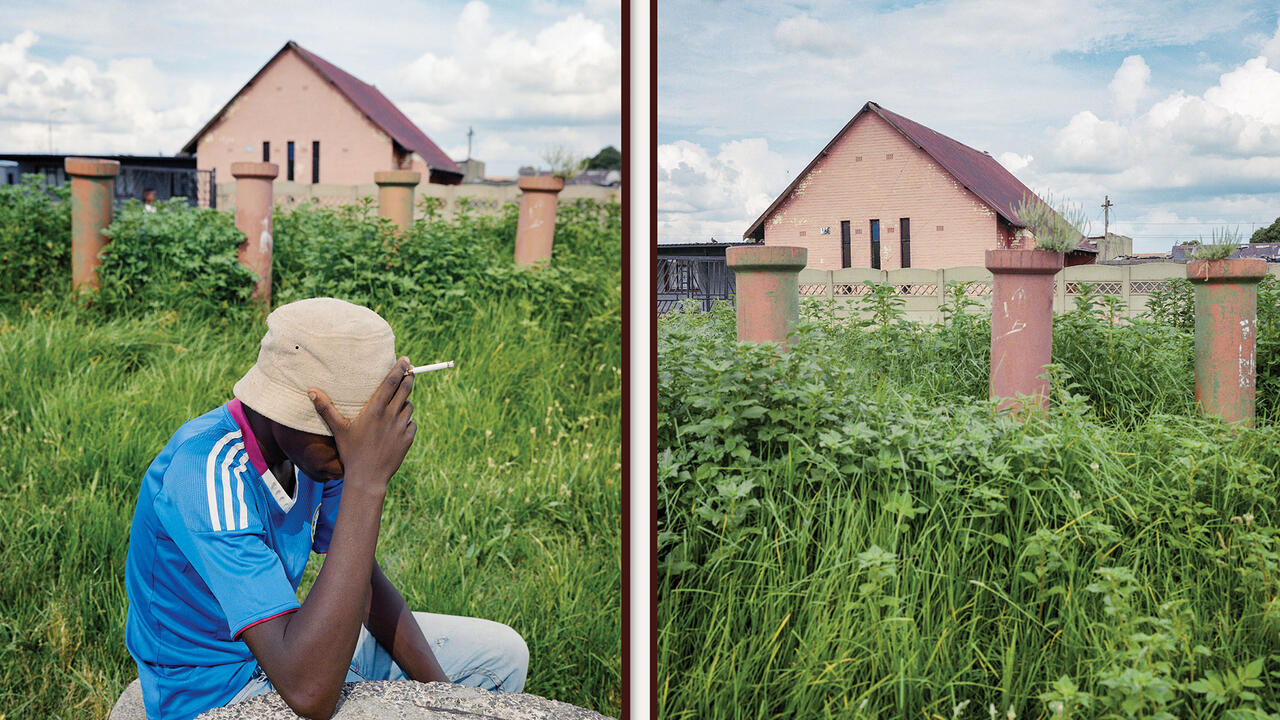The Man Who Made the News Novelesque
Before Twitter, Félix Fénéon’s daily ‘novels in three lines’ made a literary art form of current affairs
Before Twitter, Félix Fénéon’s daily ‘novels in three lines’ made a literary art form of current affairs

Félix Vallotton’s 1896 portrait of Félix Fénéon, editor of the French literary magazine La Revue Blanche (The White Review, 1889–1903), shows a shadowy figure hunched in concentration over his desk, a pile of manuscripts at his side. He is dressed all in black, pen poised, the nighttime office illuminated only by a mint-green lamp. Its colour recalls, perhaps, the glass of absinthe Fénéon is said to have been drinking two years earlier, as he sat in a bar and watched a bomb explode at a cafe across the road popular with diplomats and politicians. Rumours persisted that it was Fénéon himself who had placed the device in a potted hyacinth on the cafe’s windowsill, lighting it with the tip of his ivory cigarette holder. At his trial, detectives produced a vial of mercury and 11 detonators, which they had found in a closet at the ministry department where Fénéon worked. Fénéon claimed that his father, recently deceased, had come across them in the street and was eventually acquitted. Stéphane Mallarmé, a character witness, backed him up: ‘For Fénéon,’ he insisted, ‘there are no better detonators than his articles.’

An anarchist employed for years as a clerk in the War Office; an aesthete who shunned the limelight: Fénéon was a well-known and influential figure in the avant-garde circles of fin-de-siècle Paris. He worked tirelessly as a critic and editor to promote neo-impressionism – a term he coined in 1886 to describe the movement led by Georges Seurat. At La Revue Blanche, he published works by Claude Debussy, André Gide, Marcel Proust and Arthur Rimbaud; he commissioned the first French edition of James Joyce’s work and himself translated texts by Jane Austen and Fyodor Dostoevsky. Yet, he was a chameleonic figure who preferred to promote the work of others while remaining an enigma. ‘I aspire only to silence,’ Fénéon insisted, when urged to publish his collected essays. He tended to write anonymously or under pseudonyms (Porfiry, after the detective in Crime and Punishment, 1866; Gil de Bache, the name of a 17th-century Portuguese pirate; or, simply, ‘Hombre’). In 1895, Henri de Toulouse-Lautrec sketched Fénéon’s face emerging from a swirl of cigarette smoke, as if liable to vanish at any moment; in 1890, Paul Signac placed him at the centre of an abstract Technicolor whirl, proffering a lily to a figure out of sight. Signac’s portrait – despite the fact that Fénéon considered it his friend’s worst work – now forms the centrepiece of an exhibition at New York’s Museum of Modern Art, one of a trio of recent shows exploring Fénéon’s championing of art and artists and his impact on modernism. (Last year, a two-part sister exhibition ran at the Musée de l’Orangerie and the Musée du quai Branly in the critic’s adopted hometown of Paris.)

Yet Fénéon’s lasting legacy may be his own writing. In May 1906, working night shifts at the newspaper Le Matin (The Morning, 1884–1944), Fénéon began writing an anonymous column comprising brief, noir-ish news items, each no more than three lines long, drawn from the newswires, local reports and reader correspondence. Faits divers – also known as chiens écrasés, or flattened dogs – were a popular feature in French newspapers: Proust read them daily over breakfast, while Gustave Flaubert allegedly found the seed for Madame Bovary (1856) in an item from a provincial journal. But it was Fénéon who turned the faits divers into an art form, using them as a space for avant-garde experiment, based on the narrative power of a well-constructed sentence. These true stories of murder, lust and revenge condense whole lives into mere adjectives, devastating personal dramas into throwaway asides. Each of Fénéon’s fragments contains the richness of a novel, distilled into an epigram: their eloquence derives from his ability to say just enough, and to leave the rest to the reader’s imagination. He can offer the spectacle of a drawn-out court case in a few clauses: ‘There was talk of a pervert, but finally Porcher, of La Grange, near Cholet, was constrained to admit his wife’s murderer was himself.’ He drops incongruous details to tantalize the reader into fevered speculation: ‘Nimble though she was at stealing jewels, Marie de Badesco was nabbed in Versailles. She got two years.’ (Imagine the backstory.) Careful word order ratchets up tension before releasing its blow at the last moment, for maximum impact: ‘A dishwasher from Nancy, Vital Frerotte, who had just come back from Lourdes cured forever of tuberculosis, died Sunday by mistake.’

These pieces survive only because Fénéon’s lover, Camille Plateel, cut them out and preserved them in a scrapbook. (Apparently, his wife, Fanny, was doing the same thing.) But it’s notable that they have lasted not as news but as fiction. In 1960, a selection was published in Germaine Bree’s anthology Great French Short Stories. When, in 2007, New York Review Books Classics published an English edition, translated by Luc Sante, it was given the intriguing title Novels in Three Lines. This is a deliberately loose translation of ‘Nouvelles en trois lignes’, the title under which they appeared in Le Matin, where ‘nouvelles’ would ordinarily refer to ‘the news’. (It also means ‘short stories’.) The novel, as a form, is embedded in a sense of newness; an urgent impulse to expand its own possibilities has always been central to its identity and history. Fénéon made the news new – and turned it into literature. His style resonates in the work of several avant-garde writers of the 20th century, determined to find novel forms through which to interrogate identity and the human psyche.

Thomas Bernhard’s 1978 collection The Voice Imitator is characterized, like his major novels, by a resounding rage, an obsession with corruption and madness, and a satirist’s ability to skewer the absurdity of the human condition. It comprises 104 stories, each no more than a page long, many taken from the news and presented in the straightforward, deadpan style of an extended faits divers. We meet a paraplegic aristocrat trapped under a powerful hypnosis, who spends her days sitting on the shore of Lake Geneva, waiting for a chauffeur to bring her the newspapers; elsewhere, we learn that 180 people have died from a flu epidemic, ‘not from the flu but as the result of a prescription that was misunderstood by a newly appointed pharmacist’. The pharmacist, the narrator informs us with macabre relish, ‘will probably be charged with reckless homicide, possibly, according to the paper, even before Christmas’. Another piece reports that a team of speleologists entered a cave ‘in ideal weather conditions’, but did not reappear; nor did two rescue teams dispatched in turn to rescue them. ‘At this point the department of the Salzburg Provincial Government responsible for speleology commissioned a firm of building contractors in the Pongau to wall up the cave between Taxenbach and Schwarzach, and this was done before the New Year.’ Here the story ends, without comment on this palpably inadequate resolution.

When tragedy is consumed as entertainment, Bernhard seems to suggest, we can’t expect respite, progression, closure. Intrinsic to these stories is a sense that nothing matters; that sentiment is futile in a cruel and arbitrary world, where at any moment a hairdresser may suddenly go mad and decapitate a duke, a suicide epidemic may break out among children, teachers or librarians, or a ‘paterfamilias who had for decades been praised and beloved for a so-called extraordinary sense of family’ may murder his children one Saturday afternoon, ‘admittedly in especially humid weather’.
Bernhard’s speech on receiving the Austrian State Prize for Literature in 1967 pinpoints the sense of pointlessness that his short-form prose lays bare: ‘There is nothing to praise,’ he insisted, ‘nothing to damn, nothing to accuse, but much that is absurd, indeed it is all absurd, when one thinks of death.’ In Suicide – sent to his publisher ten days before the author killed himself, in October 2007 – the French writer and artist Édouard Levé used similar terms to express his disillusionment with conventional, linear narrative form. ‘A dictionary’, wrote Levé, ‘resembles the world more than a novel does, because the world is not a coherent sequence of actions but a constellation of things perceived. It is looked at, unrelated things congregate, and geographic proximity gives them meaning. If events follow each other, they are believed to be a story. But in a dictionary time doesn’t exist: ABC is neither more or less chronological than BCA.’

Levé was deeply influenced by the work of Georges Perec, and there is certainly something of Fénéon’s spirit in the Oulipo’s experimentation with creating meaning and pattern under formal constraints. In his 2004 novel Newspaper, Levé, like Bernhard and Fénéon, plays with the possibilities of an absent or invisible authorial voice, taking even further the unsettling effect of the faits divers. Newspaper is structured entirely in the form of a daily paper, its stories divided into sections. We move from ‘International News’, an unremitting chronicle of genocide, terrorism and ecological disaster, through ‘Society’, in which a story on the ageing population sits, in sinister fashion, next to a report on a hike in testimonies of the abuse of the elderly, to ‘Classifieds’, where rooms are advertised by the square metre and jobs are announced in deadening corporate language: ‘If you want to change the direction of your life, we invite you to join one of our teams as a commercial engineer.’ ‘Internet site seeks numerologists and astrologists. Work from home, flexible hours. Urgent.’ As the text builds, what emerges is a portrait of society in dissolution: of technological advancement tempered by acute loneliness and isolation, of random acts of cruelty and order broken down. The final section of the book, ‘Entertainment Guide’, intersperses horror and frivolity with no distinction between the two, a depraved society mirrored back onto itself. Game shows and weather reports mingle with soaps and dramas staging the murders and violence we’ve just read about in shock, this time for our enjoyment.
Does a society generate its news or does news generate society? Do our newspapers reflect us or shape us? Are we complicit in the horrors we read about daily if we do nothing about them? In his story ‘Example’, from The Voice Imitator, Bernhard suggests that the closer our proximity to the news, the more dangerously desensitized we become: ‘The courtroom correspondent is the closest of all to human misery and its absurdity and, in the nature of things, can endure the experience only for a short time, and certainly not for his whole life, without going crazy. The probable, the improbable, even the unbelievable, the most unbelievable are paraded before him every day in the courtroom, and because he has to earn his daily bread by reporting on actual or alleged but, in any case, in the nature of things, shameful crimes, he is soon no longer surprised by anything at all.’

To read Newspaper, The Voice Imitator or Novels in Three Lines in one sitting produces a strangely numbing effect. The exceptional is presented as banal; individual stories merge into an uneasy chorus of misfortune. Each of these works shows a world overrun by faceless forces, power replicating anonymously, ordinary people taking extraordinary measures without recourse to state help. Fénéon’s stories bristle with bombings, thefts, misdirected bullets, jilted partners lurking outside hotels with guns, children brawling outside schools, misadventures on train tracks. In Novels in Three Lines, written within memory of the suppression of the 1871 Paris Commune – a short-lived attempt at radical socialist government – Fénéon’s own politics are strongly evident: his snippets abound with bitter demonstrations and strike action spurred by poverty, unfair labour conditions and widespread mistrust of government. ‘Women suckling their infants argued the workers’ cause to the director of the streetcar lines in Toulon. He was unmoved.’ Desperation and disillusionment prevail: ‘“If my candidate loses, I will kill myself,” M. Bellavoine, of Fresquienne, Seine-Inferieure, had declared. He killed himself.’

Today, as we consume our news in 280 characters and flicker constantly between screens bombarding our synapses indiscriminately with information, the faits divers seems a distinctly contemporary form. Between 2011 and 2013, the writer Teju Cole posted on Twitter a project titled ‘Small Fates’: faits divers – explicitly inspired by Fénéon – drawing on Nigerian newspapers and set in Lagos. Cole’s sidelong glances at contemporary life are pithy and poignant. ‘In Ikotun, Mrs Ojo, who was terrified of armed robbers, died in her barricaded home, of smoke inhalation.’ ‘“Nobody shot anybody,” the Abuja police spokesman confirmed, after the driver Stephen, 35, shot by Abuja police, almost died.’ ‘Precious Ogbonna, of Owerri, whom God gave 7 babies, nevertheless has an intact hymen, and has been charged with child-trafficking.’ In an accompanying essay published on his website, Cole explained that he had chosen the faits divers for the form’s ability to penetrate exceptional moments in ordinary lives: because ‘what there is to know about a city, beyond the statistics, beyond population, tallest buildings, GDP, is individual human experience’. Each fragment, he argued, ‘tells a truth, a whole truth, but never the whole truth (but this is true of all storytelling)’. It’s fitting that Fénéon, who always tried to disappear, will be remembered for those moments of everyday mania he condensed into bite-size form for immediate – and lasting – consumption.
Accompanied by specially commissioned photography by Polly Brown
This article first appeared in frieze issue 211 with the headline ‘Nobody Shot Anybody’.
Main Image: “Love decidedly has a hard time sitting still. Émile Contet, 25 Rue Davy, pierced with his knife his wife’s breast.” All image captions: ‘Novels in Three Lines’ reproduced courtesy of New York Review Books Classics. Translation: © 2007 Luc Sante























